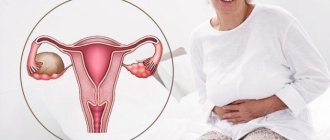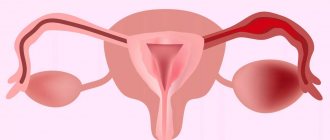Indications
A woman is recommended to undergo an ultrasound examination if, during a standard examination, signs of gynecological pathology were identified, such as:
- pain of unknown etiology in the lower abdomen before or during menstruation;
- prolonged or heavy periods;
- intermenstrual bleeding.
Ultrasound is also performed during pregnancy. The study confirms or refutes the fact of intrauterine pregnancy and excludes ectopic and hydatidiform pregnancy. The procedure is carried out to clarify the gestational age and diagnose anomalies. If problems are identified, ultrasound will determine whether they can be eliminated.
Kinds
The procedure for examining the uterus and appendages using ultrasound is carried out in 4 ways:
- Transvaginal ultrasound . During this examination, the specialist inserts a sensor into the vagina to a depth of 5-7 cm, scanning the uterus and appendages. This type of examination is considered the most informative, but it cannot always be used among women. Contraindications to transvaginal ultrasound are bleeding from the genital tract, the second and third trimesters of pregnancy, and virginity. Read more about transvaginal ultrasound →
- Transabdominal ultrasound . This type of examination is performed through the abdominal wall. The procedure is more convenient than transvaginal ultrasound, but the diagnostic results may be less informative. This type of diagnosis is most suitable for girls who have not entered into intimate relationships, as well as during pregnancy.
- Transrectal ultrasound . During this examination, the specialist inserts a sensor into the patient's anus, scanning the uterus and appendages through the intestinal wall. This type of diagnosis is no less accurate than transvaginal ultrasound of the uterus. It is practiced mainly among virgins.
- Intrauterine ultrasound . In this case, the equipment sensor is inserted directly into the uterine cavity. This method of examination is rarely used, mainly when diagnosing uterine fibroids and endometrial changes.
When is the best time to diagnose?
Ultrasound of the uterus and appendages is ideally performed on days 5-7 of the cycle. This period was not chosen by chance. It is after menstruation that the endometrium is thinnest, which makes it possible to accurately assess pathologies such as hyperplasia of the inner lining of the uterus, fibroids, etc. If the study is carried out in the second half of the cycle, the growing endometrium will hide small tumors and defects, distorting the information.
In addition, from the second half of the cycle, a follicle or cyst of the corpus luteum is normally detected in one of the ovaries. At this point, it is difficult for a specialist to assess the existing cyst - its functional or pathological nature. Small cystic inclusions in the ovaries are present from the beginning of menstruation until days 5-7 of the cycle.
To assess the functionality of the ovaries, the procedure is carried out three times during the cycle on days 8-10, 14-16 and 23-24. If the test does not show pregnancy, and the temperature in the rectum remains elevated for more than 10-14 days, an ultrasound is prescribed to exclude cystic formations.
During pregnancy, three mandatory ultrasound examinations are performed to assess the condition of the uterus and fetus.
Indications for ultrasound of the uterus and appendages
Ultrasound of the uterus and appendages is a safe procedure. Ultrasound is harmless to the body, does not cause negative consequences, and is used even when examining pregnant women. During the examination, the gynecologist may prescribe an ultrasound of all internal genital organs or just the uterus. Ultrasound of the appendages (ovaries and fallopian tubes) can be performed separately. Routine diagnosis of the ovaries and uterus is carried out during a preventive examination, at the stage of planning conception, during pregnancy, after childbirth or cesarean section.
Ultrasound is prescribed as a diagnostic in the following cases:
- Pain in the uterine area;
- Irregular menstrual cycle;
- Lack of menstruation;
- Painful menstruation;
- Bloody discharge outside of menstruation;
- Suspicion of a neoplasm in the uterine area;
- Pain during intercourse;
- Purulent vaginal discharge;
Preparation
Ultrasound of the uterus and appendages is performed in several ways.
Each of them has its own preparation characteristics:
- To perform a transabdominal examination, a woman must have a full bladder. It is not difficult to prepare for an ultrasound of the appendages and uterus: it is recommended to drink at least 0.5 liters of water within an hour before the procedure. A full bladder gently pushes back the intestinal walls, making it possible to more clearly examine the condition of the pelvic organs. If this condition is not met, the study will be uninformative. If a woman has problems with bowel function, flatulence or chronic constipation, which may interfere with diagnosis, in preparation for transabdominal ultrasound of the appendages and uterus, it is recommended to follow a diet that improves digestion for two days, and take medications to remove gases and feces.
- To conduct a transvaginal ultrasound, on the contrary, the bladder must be emptied before the examination so as not to hide the image of the pelvic organs. Before inserting the sensor into the vagina, a condom or latex nozzle is placed on the surface of the scanner and a sound-conducting gel is applied. If you are allergic to latex, you should notify your doctor.
- How to prepare for transrectal ultrasound of the uterus and ovaries? It is necessary to have a bowel movement approximately 6 hours before the procedure. To do this, a woman can use a ready-made microenema (Microlax, Norgalax), give a cleansing enema or take a laxative (Senade, glycerin suppositories).
- To perform an intrauterine ultrasound, no fundamental preparation is required. The study is carried out with an empty bladder.
How is an ultrasound of the uterus and appendages performed?
Depending on the indications, there are four methods of examining the uterus, which require different preparation. The price of the procedure does not depend on the research method.
Transvaginal method.
- How it is carried out.
The patient undresses to the waist, lies on the couch on her back, with her knees slightly bent. A condom is placed over the sensor and then inserted into the vagina. Since ultrasound waves travel a short path from the sensor to the organs, this method of ultrasound of the ovaries and uterus is considered the most accurate. - How to prepare.
If possible, it is best not to drink a few hours before the procedure, and you should empty your bladder immediately before the procedure.
Abdominal method.
- How it is carried out.
The patient needs to remove clothing from her lower abdomen. A special gel is applied to the skin in the study area. To obtain an image, the doctor moves the sensor along the front wall of the abdomen. This method can be combined with transvaginal examination. - How to prepare.
The day before the diagnosis, you need to give up carbonated drinks, black bread, confectionery, cabbage and other foods that increase gas formation. An hour before the test, you need to drink 1 liter of water or not urinate for 2-3 hours before the procedure to keep your bladder full.
Transrectal method.
- How it is carried out.
The patient undresses to the waist and lies on the couch on her side. For diagnosis, a thinner sensor is used than with vaginal ultrasound. A condom is put on it and inserted into the rectum. This method is used to examine girls who are not yet sexually active, if the data obtained from the abdominal diagnostic method was insufficient, and if a serious pathology of the uterus is suspected. - How to prepare.
6–8 hours before the procedure, you need to cleanse the rectum with an enema.
Intrauterine method.
- How it is carried out.
The patient undresses to the waist and lies down on the couch with her knees bent. A thin sterile probe with an ultrasound transmitter is inserted directly into the uterine cavity (as with a vaginal ultrasound, only deeper). Such a study is prescribed only according to indications (for example, if neoplasms are located deep in the lining of the uterus). - How to prepare.
This method does not require special preparation.
If you have already had an ultrasound scan of the uterus or ovaries, take the results with you. They will help assess the dynamics of change.
To find out information on preparing for an ultrasound of the uterus and appendages in Moscow, how much the procedure costs, or to ask other questions, contact a consultant at our call center. He will also select the most convenient time for you to visit the doctor.
Carrying out the procedure
The simplest procedure is transabdominal ultrasound. The patient lies down on the couch, frees the abdominal area, onto which the doctor applies the gel. The procedure lasts about 20 minutes.
For a transvaginal ultrasound, the woman undresses from the waist up and lies down on a couch. The doctor inserts a probe with a sensor at the end into the vagina. If the procedure is performed transrectally, a thinner probe is used. During this study, the patient lies on her left side. Both procedures also last no more than 20 minutes.
For intrauterine ultrasound, the patient undresses to the waist, lies on the couch, inserting her legs into special stirrups. A speculum is inserted into the vagina, followed by a catheter. After this, the speculum is removed, replacing it with a vaginal sensor, which is placed in the uterine cavity. Using a catheter, a saline solution is injected into the uterus, which should slightly expand the organ. If it is necessary to evaluate the condition of the fallopian tubes, saline is injected with air, and the doctor evaluates on the monitor how gas bubbles pass through the fallopian tubes. The procedure lasts on average 30 minutes.
Transabdominal access
Gynecologists use this method of examination most often because it is informative, simple and does not require special training. The process is as follows: the woman exposes her stomach and lies down on the couch, and the doctor moves the sensor over the surface of the skin. The only condition is a full bladder. For this purpose, the patient must refrain from urinating for 2-3 hours before the test or drink 0.5 liters of liquid 40 minutes before it.
Transabdominal access means examination through the abdominal cavity
Transabdominal ultrasound is performed for the following indications:
- pregnancy;
- disease prevention;
- painful sensations in the lower abdomen after childbirth, during menstruation or for no reason;
- violation of the cyclicity of menstrual flow;
- lack of blood during menstruation without development of pregnancy;
- pathological vaginal discharge;
- infertility;
- suspicion of pathology;
- to assess the quality of the operation performed;
- monitoring of detected diseases, etc.
Women who are planning a pregnancy, have given birth, or are in menopause undergo an ultrasound scan without fail.
Errors
Diagnosis using ultrasound is a reliable and accurate method. It has been proven that the scanner error can be no more than 10%. With the help of this device, you can not only determine the fact of pregnancy at an early stage, but also determine its real timing accurate to the day.
The possibilities of ultrasound are vast, but we must not forget about the human factor. The accuracy of the diagnostic result directly depends not on the device itself, but on the professionalism of the specialist. Also, the doctor must inform the patient how to prepare for an ultrasound diagnosis of the uterus and appendages and how the procedure is performed.
Decoding
Usually, the doctor gives the results of the examination to the woman on the day of the procedure. The interpretation of the ultrasound includes data on the shape and size of the uterus, the thickness of the endometrium, the structure of the cervix, the size and structure of the ovaries, and the presence of follicles.
Uterine cavity
The structure of the uterus should normally be homogeneous. The contours of the organ must have clear boundaries. If the picture is blurry, the specialist draws conclusions about the inflammatory process. The detection of hyperechoic inclusions may indicate polyps, fibroids and organ cancer.
In a nulliparous woman, the uterus has a length of 43-47 mm, a width of 42-50 mm, and a thickness of 32-34 mm. For those who have given birth, the sizes will be larger, within 10 mm.
Cervix
The normal length of the cervix is 20-40 mm, the anterior-posterior size is 25-35 mm. According to ultrasound, its structure should be homogeneous.
The cervical canal, filled with mucous contents, has a diameter of up to 3 mm. If the neck or canal is enlarged, we may be talking about inflammation.
Free fluid inside the pelvis
Immediately after ovulation, a small amount of fluid is detected behind the uterus. This is the norm. If the fluid is detected at another time, most likely we are talking about inflammation in the pelvic organs.
Ovaries
Normally, the ovaries measure 25x30x15. The volume of the ovary is 5-8 mm³. If these parameters are higher than normal, we may be talking about polycystic disease or oophoritis.
Normally, the ovary contains several follicles 4-6 mm and one dominant follicle up to 25 mm. If its diameter exceeds 25 mm, we are talking about a functional cyst.
The fallopian tubes
Ultrasound of the fallopian tubes is performed as a separate study, allowing an accurate assessment of their functionality. It is prescribed to women who suffer from infertility.
During the procedure, the doctor fills the uterine cavity and tubes with a contrast agent, after which he evaluates the patency of the latter on the monitor. With a regular ultrasound, it is impossible to assess the condition of the fallopian tubes, since their lumen will not be visible.
Bicornuate uterus
It is a consequence of the pathology of the patient’s intrauterine development. This condition is fraught with infertility, miscarriages, and intermenstrual bleeding.
Ultrasound determines a bicornuate uterus in the form of division of its cavity into two sections. Other anomalies that usually accompany it are also identified.
What can the doctor see?
Transabdominal examination allows you to determine the shape, location, contours, echogenicity (uniformity of structure) and size of the uterus. Indicators of the endometrium, cervix, ovaries, and the structure of muscle tissue are also assessed. If they want to diagnose pregnancy, the specialist additionally evaluates the tone of the uterus and the location of the fertilized egg.
Using ultrasound, you can detect benign and malignant tumors, cysts, malformations, inflammatory diseases, ectopic pregnancy, polyps and other pathological conditions of the reproductive organs.
Interpretation of ultrasound: normal indicators
In a healthy woman, a transabdominal ultrasound of the uterus will reveal the following indicators:
- 4.5–6.7 cm in length, 5–6.4 cm in width, 3–4 cm in thickness in women 15–40 years old;
- the contours are smooth and clear;
- homogeneous echogenicity of the walls;
- cervical canal 2-3 mm;
- the cervical canal is filled with homogeneous fluid;
- normal tone;
- endometrial thickness depending on the day of the cycle (1-15 mm).
Healthy ovaries should be 3-4.1 cm long, 2.0-3.1 cm wide and 1.4-2.2 cm thick with a homogeneous echostructure. In them, the dominant follicle is determined by the middle of the cycle, and an uneven contour is also visible. The fallopian tubes are not recognized.
Normally, it is possible to determine a small amount (several milliliters) of free fluid in the pelvis on the 14-15th day after the next menstruation. At other times it should not be recognized.
Doctors often write in their conclusions “decidualization of the endometrium.” This indicates pregnancy.
Ultrasound signs of uterine pathologies
Ultrasound primarily helps diagnose cancer at an early stage of its development. Affected tissues have a different echogenicity than healthy ones, however, a malignant tumor can be confused with fibroids. To make an accurate diagnosis, the woman is referred for a biopsy.
Endometriosis of the uterus can be suspected by the heterogeneous structure of the organ, its increased size and the discrepancy between the thickness of the endometrium and the days of the menstrual cycle. Characteristic is the proliferation of the mucous membrane in the muscular layer of the uterus and the formation of cysts.
During the examination, the doctor can detect formations of any size, characterized by increased density and spongy structure. It can be single or multiple, and also occupy the entire uterine cavity or some part of it. This is a uterine polyp. It is also characterized by smooth and clear edges.
Doctors often diagnose abnormalities in the development of the uterus. The most common of them are:
- hypoplasia (violation of organ proportions);
- saddle uterus (a depression in the bottom of the organ);
- bicornuate uterus (symbolic image of the heart);
- duplication of the uterus, etc.
If the doctor’s report states that the uterine cavity is dilated, hyperechoic inclusions are visualized, and the structure of the endometrium is heterogeneous, then this means that the woman has chronic endometritis. The acute phase of inflammation is characterized by a decrease in the echogenicity of the mucous membrane.
Ultrasound helps to quickly determine a woman’s pregnancy, both normal and pathological (ectopic). Already at a period of 4-5 weeks, the doctor is able to recognize the embryo in the lumen of the fallopian tube or uterus. An indirect sign of an ectopic pregnancy is the absence of a fertilized egg in the uterus.
Signs of ovarian pathology
Transabdominal ultrasound determines the size of the ovaries, their structure and the presence of pathological formations. Cancer can be suspected by the asymmetry of the organ, the appearance of zones of hypervascularization, the determination of fluid, as well as the visualization of any formation during menopause. Consultation with an oncologist is required if two of the above symptoms are present.
An ultrasound will immediately detect an ovarian cyst. It looks like a round bubble with clearly visible contours. The doctor will determine the contents of the formation and can approximately determine its type (dermoid, follicular). With polycystic ovary syndrome, an ultrasound will show an increase in the size of the appendages and thickening of their capsules. Many follicles ranging from 0.2 to 0.9 cm will be visible in the ovary.
The inflammatory process in the ovaries is characterized by an increase in the size of the appendages, the boundaries become unclear, and the echostructure increases. In conclusion, the doctor will note that the walls of the fallopian tubes are thickened, which indicates their involvement in the pathological process.
Ultrasound examination of the uterus and its appendages is an informative method for determining gynecological diseases. The procedure is performed in private and public medical institutions and outpatient clinics. When choosing an organization, you should pay attention to the quality of the ultrasound machine and the qualifications of the doctor performing the diagnostics.
Pathologies detected by ultrasound
When conducting a diagnostic study, a specialist may detect the following diseases:
- Uterine fibroids . This is a benign formation from the muscular layer of the organ. There are several fibroid nodes, their sizes vary from a few millimeters to 50 cm. Ultrasound determines the number, size, location and growth dynamics of fibroids.
- Hyperplasia and endometrial polyps . Hyperplasia is characterized by diffuse or focal excessive growth of the endometrium. Its thickness in this disease is more than 7 mm in the first phase of the cycle. Polyps form from focal hyperplasia. There may be several of them, the size of the formations can reach several centimeters. Using ultrasound, these conditions are assessed and the necessary treatment is prescribed.
- Ovarian cysts and tumors . Cysts can be functional or pathological. The former appear and disappear again during the cycle without any intervention. Pathological cysts require treatment. Ovarian tumors may indicate oncology. Therefore, decoding an ultrasound image of a neoplasm in the ovary is a responsible task that is solved by more than one specialist.
- Apoplexy or ovarian rupture . This is a dangerous condition that occurs spontaneously, for example as a result of injury. Ultrasound allows you to distinguish apoplexy from ectopic pregnancy or appendicitis, evaluate bleeding, and make the correct diagnosis.
- Tuboovarian formations - hydrosalpings . Appear against the background of inflammation in the pelvic organs. Ultrasound of the appendages and uterus not only reveals this abnormal condition, but also helps eliminate it using hydrotubation of obstructed fallopian tubes under ultrasound guidance.
- Pathologies associated with pregnancy . It could be an ectopic pregnancy, a frozen pregnancy, or a hydatidiform mole. A placental polyp may be detected: if an ultrasound of the uterus and ovaries after a cesarean section, natural birth or abortion reveals a remnant of placental tissue in the organ cavity, its urgent removal is necessary.
Reliable results of decoding an ultrasound of the uterus and its appendages require a specialist to have excellent knowledge of the anatomy and physiology of the female body, as well as the clinical situation. The results of the study can only be assessed by a person with a medical education. You cannot independently decipher the ultrasound protocol and determine the diagnosis, as some women do.
Author: Olga Rogozhkina, doctor, especially for Mama66.ru









